Normally, when you see those words, it means some techie details about software issues that are being corrected, but here, it’s nowhere near that exciting. Instead, we’re going to talk about breaking news on the arthropod front – cue triumphant newsreel music.
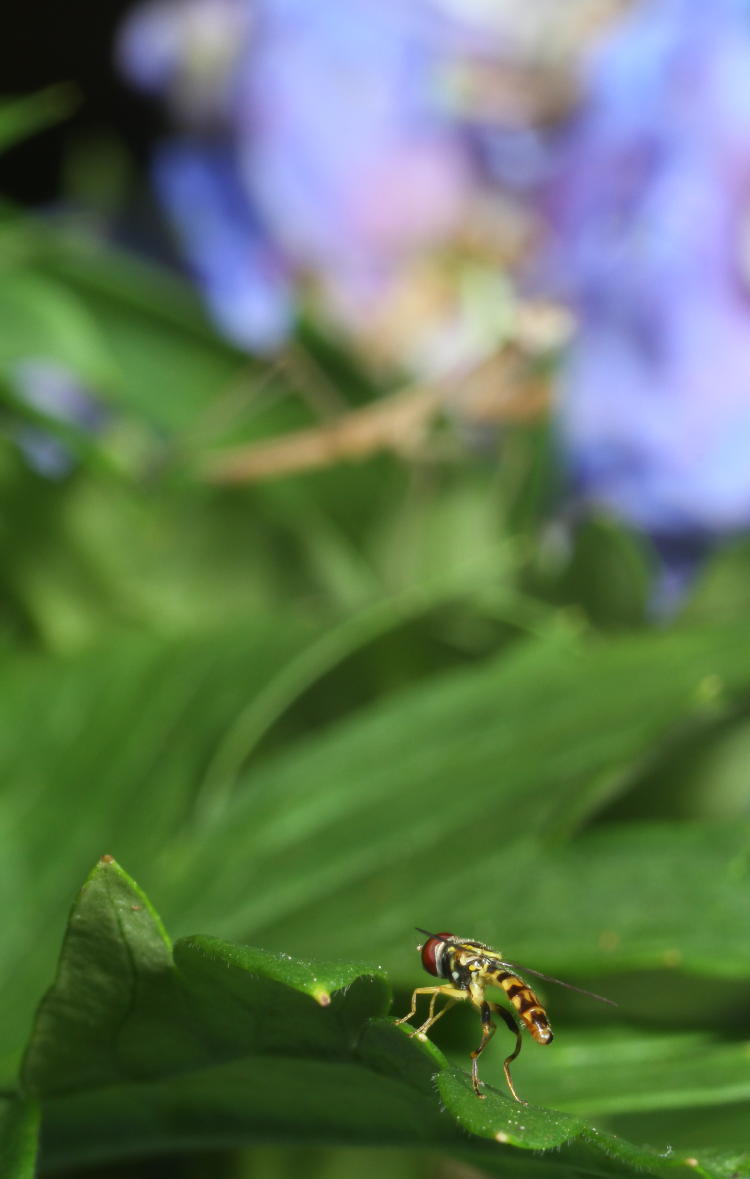
Just after sunrise the other morning, I was examining several of the plants in the yard and noticed that a trio of hoverflies seemed rather infatuated with one of the delphiniums, two of them flitting around while one usually perched on one of the leaves unless they got too close. What this meant, I don’t know – I try not to be too obtrusive with the lives of flies – but it attracted the attention of someone else, who actually appears in the photo above if you look close. Not fully prepared for a video session but unwilling to go get the proper equipment, I decided to wing it and simply shoot handheld.

A juvenile Chinese mantis (Tenodera sinensis) had also noticed the presence of the hoverfly, and began stalking it with glacial slowness. I stayed put and watched as it drew closer, endeavoring not to spook anybody and hoping to snag video of a capture. It didn’t quite pan out, so numerous video clips of the stalking and several stiff joints from the awkward position never led anywhere, so I consoled myself with still photos instead.
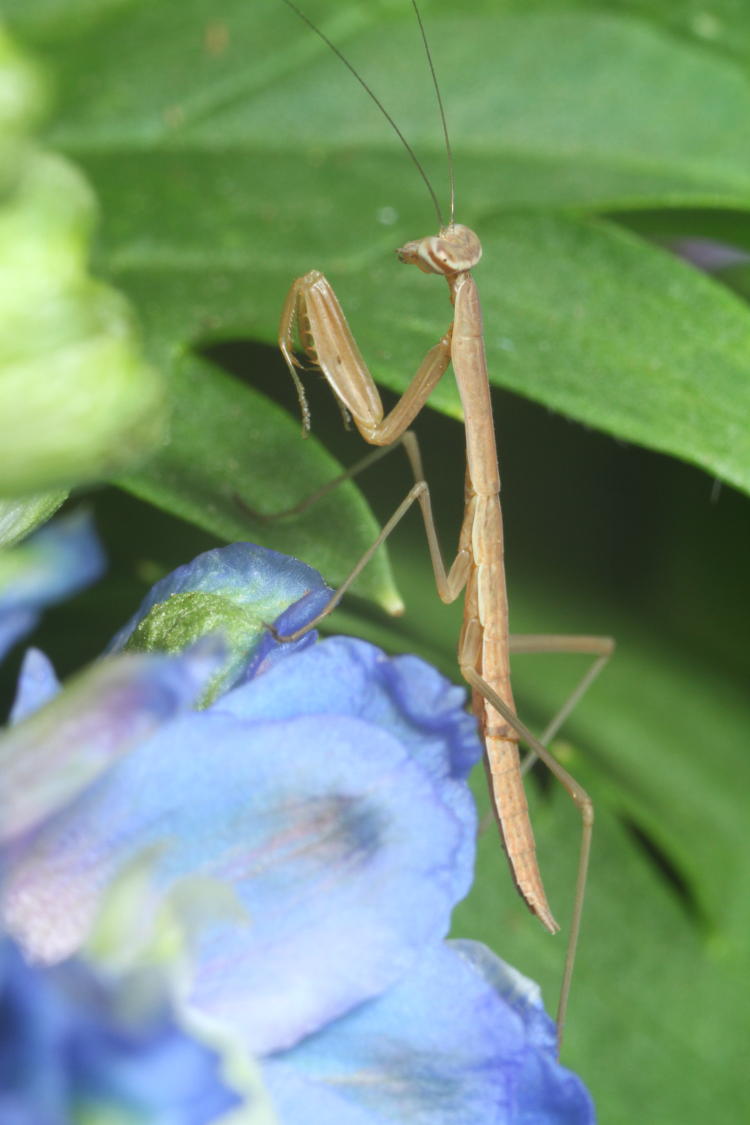
It was actually more than a little disappointing, because this was behavior that I’d really love to capture on video, and it tends to be very sporadic and hard to even witness, much less get decent clips of, and here it was promising to happen right smack in front of me without ever coming to fruition. If and when I’m ever successful, maybe a couple of these recent clips will be used to help illustrate the process, but I can’t see the point in doing a bunch of editing for no visible payoff in the video right now.
On the same plant, a jumping spider was appearing and disappearing as it hunted for available prey. My first good view, however, had the macro flash blocked by the very leaf the spider was perched upon.

Even though I’ve only featured them here once or twice before (and thus had to have it handy,) I remember the Latin name easily: Hentzia mitrata, with no apparent common name. They’re distinctively colored, and not uncommon around here. Eventually, my subject ventured further out where the flash could have the proper effect.
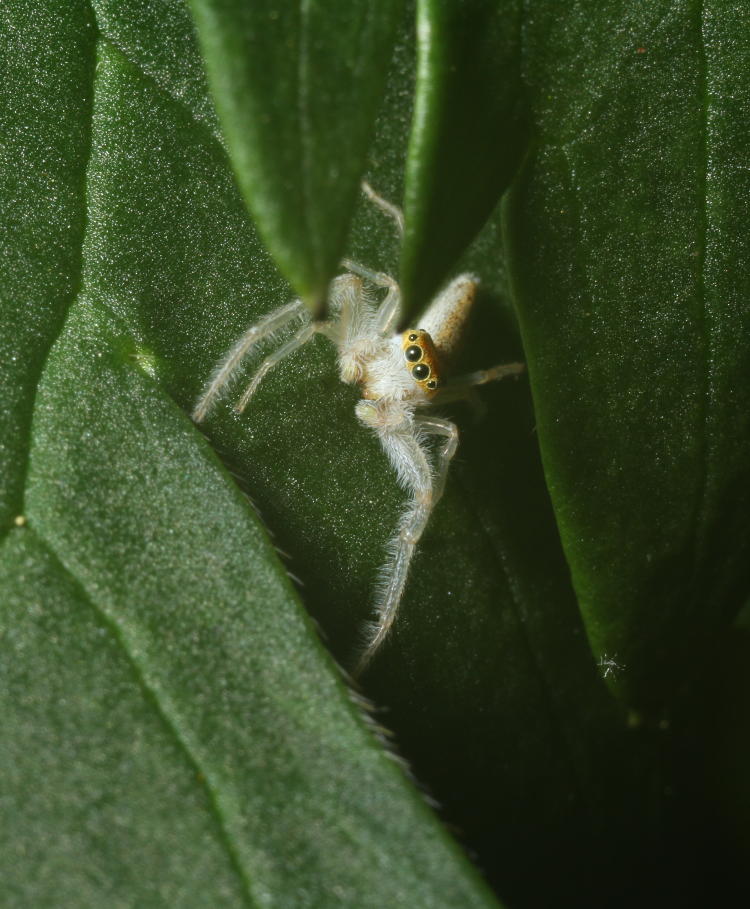
I suspect it’s simply the white coloration, though the large eyes might have something to do with it, but I consider these guys almost cute in a fuzzy-terrier sort of way. Would it be the same if they were black, or maroon? Is it just my own weirdness? The answers to these questions… will probably not come anytime soon.
Meanwhile, examining the flowers on the oak-leaf hydrangea (Hydrangea quercifolia) confirmed my suspicion that it’s a favorite haunt of crab spiders.
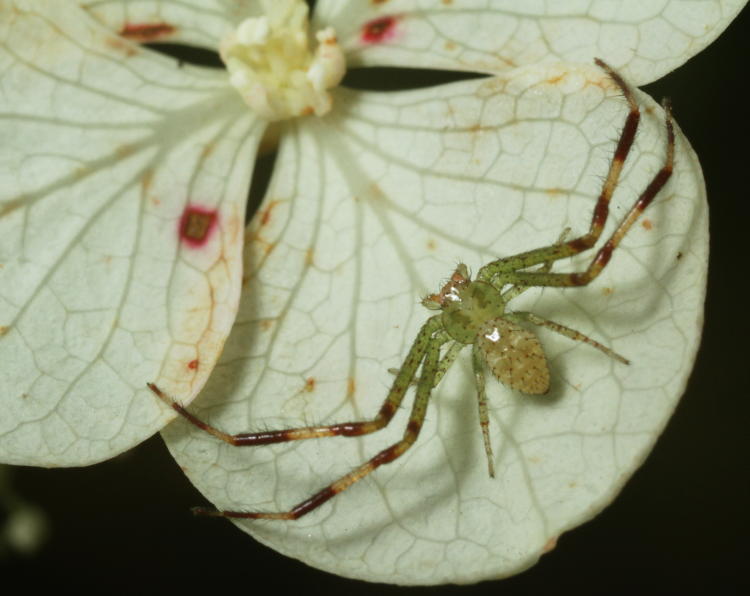
I don’t know the species, but I see them semi-regularly on the hydrangeas – though as yet, I have neither seen them with prey or any actual insects pollinating the flowers to begin with, so maybe they’re not too bright. Move to the butterfly bushes, guys.
(That’s what we regular writers call a segue…)
We have two new butterfly bushes (Buddleia davidii) in the yard, which I’ve always found to be very attractive to arthropods of all kinds, and so far they’re proving this even in the brief time that they’ve been here. The paler one (though the flowers are coming in darker now that it’s been transplanted) is shown here, playing host to an unidentified species of bumble bee.
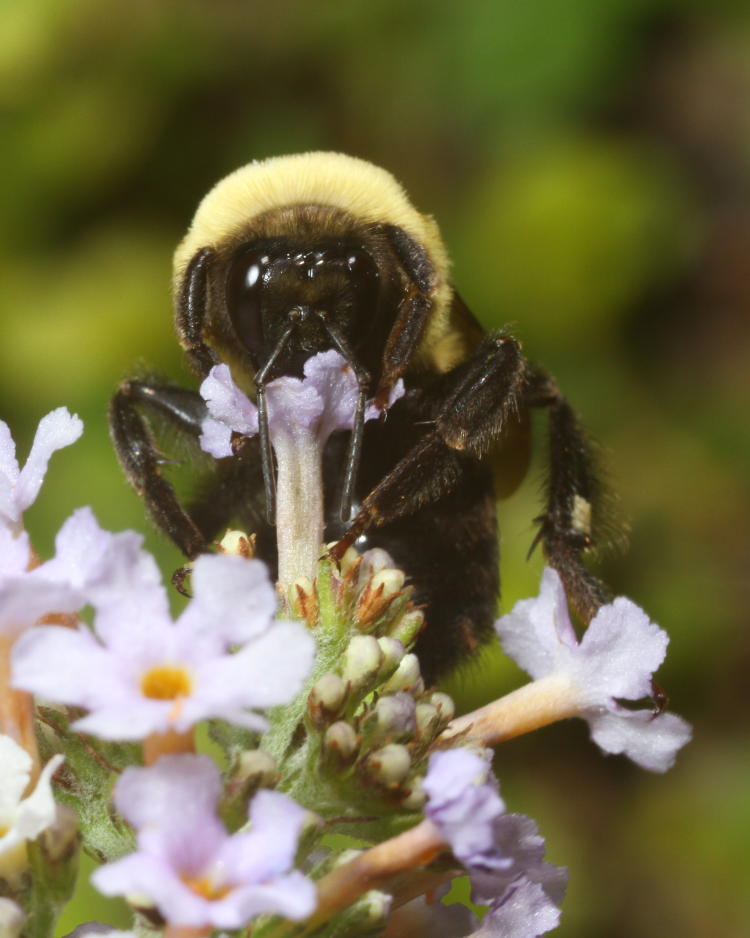
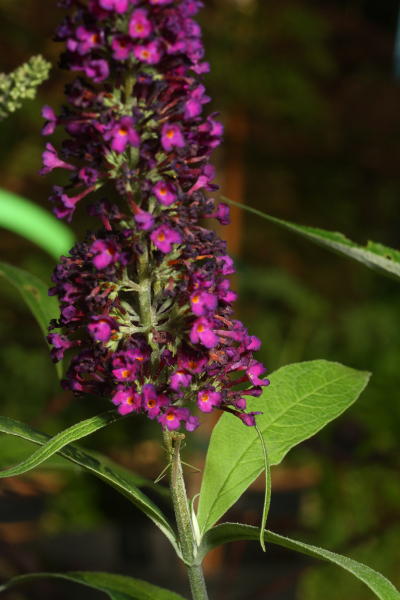 There’s something that I want to point out about that image above, and it’s the forelegs. Because that’s them up alongside the eyes, pulled close to the head and clasping the top of the flower to hold it still while the bee plunges its proboscis within – the uppermost joints sit almost completely hidden behind the bee’s head. Like all arthropods, the legs all originate from the same region underneath the thorax, right next to each other, so the foreleg position here just looks bizarre.
There’s something that I want to point out about that image above, and it’s the forelegs. Because that’s them up alongside the eyes, pulled close to the head and clasping the top of the flower to hold it still while the bee plunges its proboscis within – the uppermost joints sit almost completely hidden behind the bee’s head. Like all arthropods, the legs all originate from the same region underneath the thorax, right next to each other, so the foreleg position here just looks bizarre.
Meanwhile on the ‘black knight’ variety nearby, an occupant that I knew was there showed its prowess at remaining hidden, and I purposefully used a smaller image to illustrate what it looked like from a typical viewing distance, instead of the invaded-personal-space closeups that I normally display, and to which we will return in a moment.
Found it yet? It’s pretty small, but the legs are the clue. Or I can simply say that I’m now paranoid about cutting off the clusters of dead blossoms, part of the routine maintenance of butterfly bushes. If that’s not enough, the next photo will help.
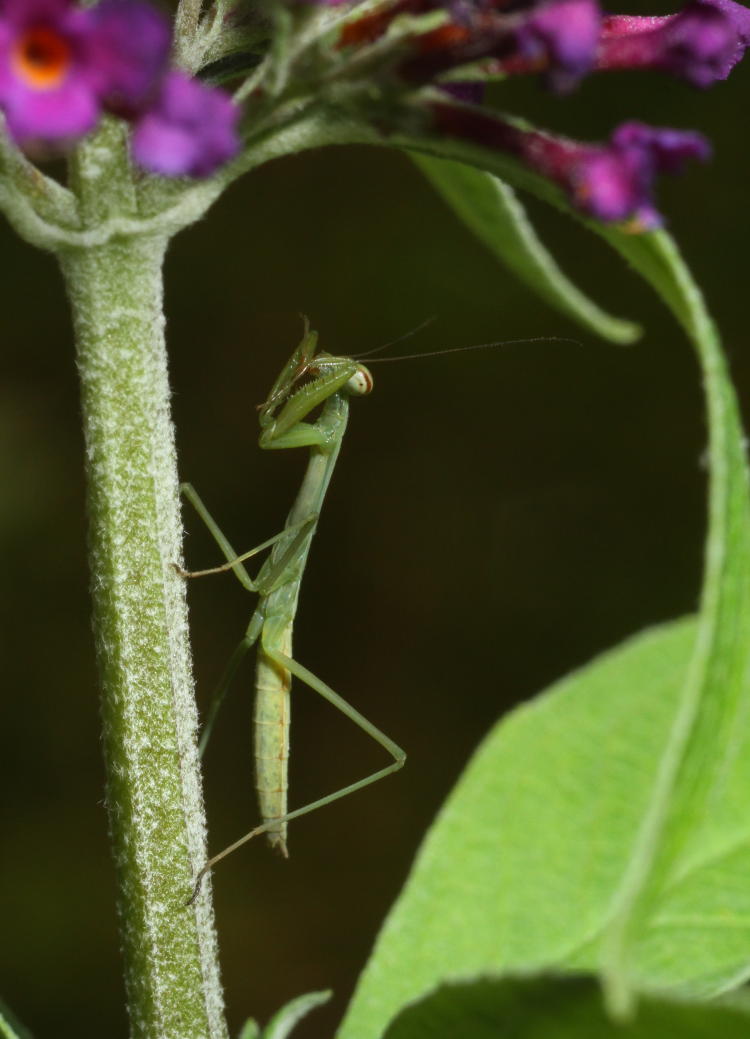
It’s pretty clear that the bumble bees, and most of the other visitors to the bush that I’ve seen, have nothing to fear from this mantis. At least not yet. Give it time.
I’ve also seen some minuscule, bright green crab spiders, small enough to actually take shelter within one of the blossoms, but not while I had a camera in hand (hard as that may be to imagine.) I’ll show one off someday.
Nearby on one of several Japanese maples that we now own, another mantis snacked on… something.
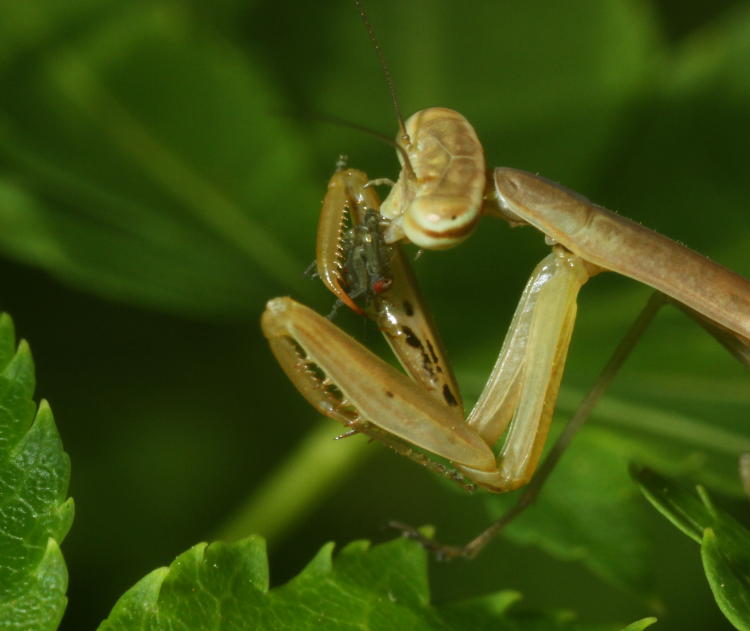
This mantis was slightly larger than the one on the butterfly bush, but still fell around 20-25mm in length, so the meal is something quite small. It doesn’t look like it in this pic, but they camouflage wonderfully within the maples – the ones that have green leaves, at least.
That’s all the front yard. In the back yard, I happened across a little farm going on.

Ants are notoriously hard to differentiate and identify, especially if you’ve left them be and don’t have one to manipulate and examine, so I’m just saying these are large red ants, common and harmless to people (I say this as someone who routinely attracts the attention of fire ants when in the vicinity, little fuckers.) Their presence on the curled up leaves of some unidentified shrub drew my attention within the leaves, which are fairly visible here but I went in for better detail.
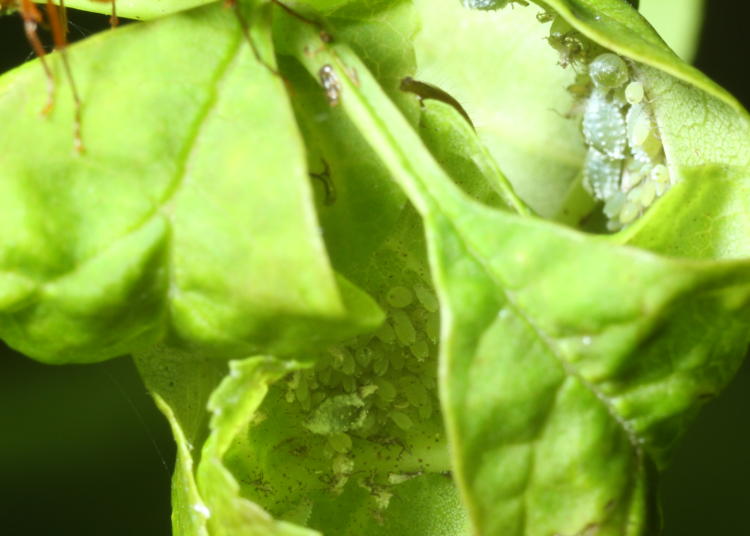
That’s a cluster of aphids in there, most likely causing the leaves to curl up to begin with, but this is a small tree that I’m going to remove anyway so I don’t mind. And neither do the ants, because they ‘milk’ the aphids for their ‘nectar,’ to cross metaphors confusingly.
Here’s the scenario. Aphids suck plant saps and cycle it through pretty quickly, only getting a little bit of nutrients from their simple digestive systems, and thus excreting slightly-weakened sap. The ants know that the aphids will excrete in a defensive manner when irritated, which the ants do by tapping the aphids with their antennae, and then the ants collect the sap from the aphids, in effect farming the aphid colonies.

I was having enough trouble, both trying to get the flash to illuminate the sheltered aphids, and just nailing focus on these leaves on the tips of thin branches swaying easily in the slightest breeze, so getting video of the farming wasn’t going to happen without a lot of prep work, tripod and light stand and stabilizing arm for the branch and so on. Maybe later.
And finally, we have a story. Simply checking out the nearby pond the other night by headlamp, I was casually examining the reflections I was getting from the water surfaces and within the grassy areas, which always turn out to be spiders, just different varieties (their eyes reflect light amazingly well, but only if the source light is held close to your own eyes.) I happened to find a medium-sized wolf spider (genus Lycosidae) sporting her young on her back, something that I haven’t seen for a few years now – and my camera was back at the house. Noting her position and that she wasn’t moving much, I went back and fetched it, knowing it would be a few minutes to do so and the chances of her being in the same vicinity was minimal. Sure enough, once I returned I couldn’t find her.
I amused myself with chasing the frogs again, and trying yet again to see if I could spot the cricket frogs that I was hearing, and on giving up for the night I had to pass through the same spot and gave it one last try. Which paid off nicely.
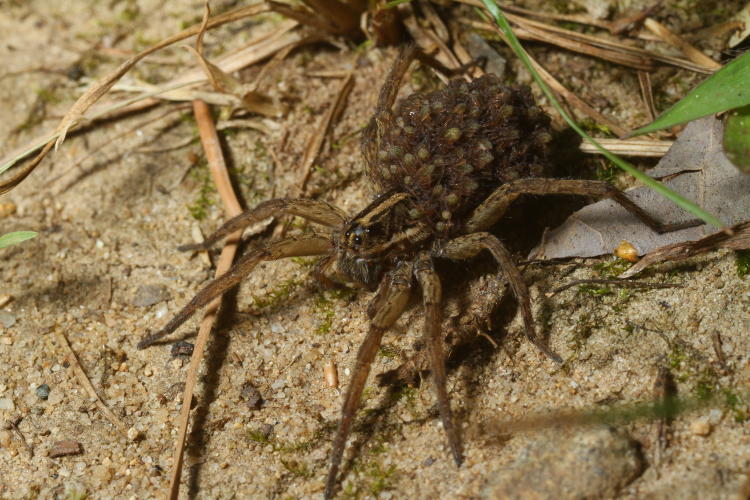
Body length for the mama was perhaps 15-18mm – like I said, medium-sized – so your guess as to how small the bebbies are. But I had the extension tube in hand, at least, and could go in a bit closer, though I started blocking the headlamp and had to remove it to lay it on the ground for a focusing light.

I realize I’m in a rut again, what with the last On This Date post immediately preceding this one, but hey, that was years ago – this is current. Plus you got a lot of other subjects too, so hush.




















































